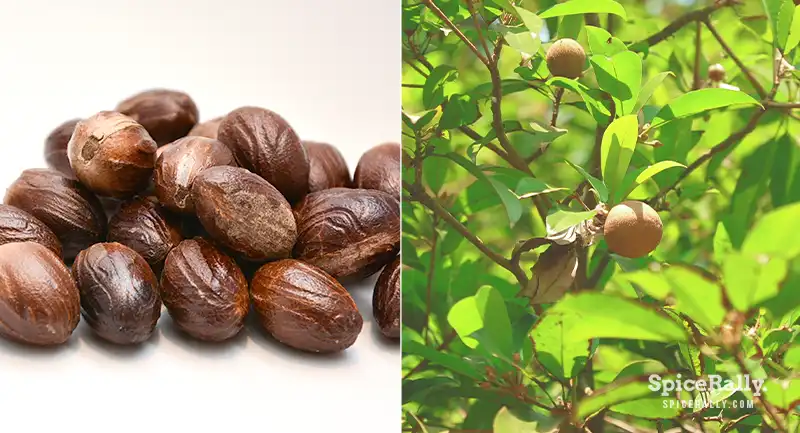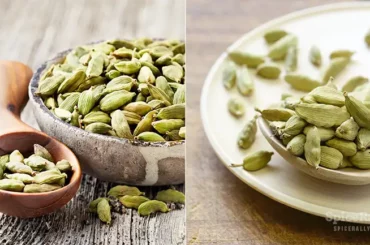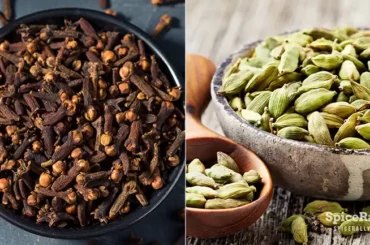There’s no doubt about the rich, exotic flavor and aroma that nutmeg lends to our food. So, if you are interested in having your own nutmeg cultivation at home, we are here to guide you with it. Let’s see how to grow nutmeg at home successfully.
As you know, nutmeg is a tropical, evergreen plant that is native to Indonesia. This crop succeeds in mostly sunny locations with hot and humid climates, along with partial shade. Nutmeg plants require well-drained, rich, organic soil with an average texture that contains less salinity. This plant can be grown from the seed, or purchase a small plant from your local gardener.
How To Grow Nutmeg In Your Home Garden?

Having a nutmeg tree in your home garden can be a great privilege since you’ll be getting two spices from one tree: nutmeg and mace! Besides, this evergreen tree provides so much shade if you love having big trees in your garden.
However, you might take a little time to get the harvest. Yet, the wait is worthwhile since one tree produces about 2000 fruits, on average, annually. So, you can have some for consumption and consider making some extra money from the rest!
Since this plant is tropical, it thrives in USDA zones 10 and 11. Since the tree gets large with maturity, you’ll need enough space in your garden if you want the plant to succeed. You can plant the seed in a pot, keep it indoors when it is young, and transplant it outdoors when necessary.
Plant Description
The nutmeg tree has a natural tapered shape with a grayish-brown trunk and dark green lustrous leaves. The branches of this tree are disseminated in loops, and the leaves are formed in oval or pointed shapes. Leaves are arranged irregularly on the branches and are 2–6 inches long, greasy, and more delicate in color underneath.
The tree produces clusters of multiple male flowers, whereas the female flowers are delivered alone or in a maximum bunch of three. The flowers are pale yellow in color and aromatic. The fruit of the nutmeg tree is a spherical, succulent berry that shatters into two halves when it ripens.
The nutmeg seed kernel inside is glossy dark brown, and elliptical in shape. The seed coat is shrouded by a lacy red membrane which is connected at the bottom of the seed. Nutmeg trees can go a height of 66 feet and may exist upwards of 80 years.
Click on this link to discover everything you need to know about nutmeg and its uses.
Choosing A Good Seed
Dark brown, full-sized seeds of matured fruits from specified mother plants are used for planting. Most importantly, seeds should be fresh and not dried. You can also get a young plant from a plant nursery and consider replanting it. When choosing a plant, ensure that it is healthy and is not affected by any pests.
Choosing The Ideal Location
Nutmeg is a tropical plant that must be grown outdoors. As mentioned before, this plant requires a hot, moist climate. In order to succeed, nutmeg shouldn’t be grown in spots with a minimum temperature below 30°F. Preferably, it needs a moderate temperature between 77°F and 95°F.
Nutmeg trees also develop best in circumstances that get at least 60 inches of yearly rainfall. And you should remember that the roots don’t thrive in soggy states. Thus it would be best to plant the tree on a slope to supply adequate drainage.
Make sure your nutmeg tree receives 12 hours of daily sunlight for wholesome growth. It is always a good idea to plant nutmeg in a location where it will accept light shadiness between noon and 4 pm so that it does not become excessively arid.
Monitoring The pH Level Of Soil
Nutmeg succeeds best in neutral or barely acidic soil, and it would be best if your soil had a pH between 6.0 and 7.0. Nevertheless, it can endure a pH between 5.5 and 7.
And this crop requires clay loam, red laterite, and sandy loam soils. You can get the help of a testing kit from your local nursery or garden supply store to check the soil’s pH level.
If the pH level of your soil is beyond 7.0, you can make it more acidic by about 1 to 2 inches of sphagnum peat into the soil once you plant the nutmeg. And if the pH level is below 5.5, you can make it a bit less acidic by surrounding the planting zone with a layer of limestone and combining it with the soil.
Preparing The Seed
To begin with, you need to separate the seed from the aril (the membranous coating) that covers it. You can get the help of a small, sharp knife to get this done. Wipe the blade with a paper towel soaked with rubbing alcohol to sterilize it. Or else you can also plunge the knife’s blade into a pot of boiling water and sterilize it.
Once your knife blade is sterilized, use it to cut into the aril at the bottom, where it connects to the seed. Peel the aril away carefully, ensuring you don’t damage the nut. Save the arils, and dry them to produce mace!
As the next step, keep your seeds in a small container and cover them with clean water. Let them soak for 24 hours before planting them. This step is essential since nutmeg seeds germinate best when fresh and damp.
Note – If you don’t need to plant the nutmeg seeds immediately, store them away in a well-sealed plastic bag and pop them in the refrigerator. But make sure you plant them within six weeks.
Let’s Get Going With Planting!
Add free-draining soil to a 5-inch pot to plant the nutmeg. The pot should contain drainage holes in the base to verify that the roots don’t become saturated. Make a 01-inch deep hole in the middle when your pot is loaded with soil. Place the nutmeg seed in the hollow, and cover it with soil.
Once the seed is planted underneath the surface, run some clean water over the pot. Keep watering the pot until the water emerges through the drainage holes, and let it empty entirely in the sink. You can use tap water for watering the nutmeg, but ensure that it is not softened water, which usually contains salt.
You can place the pot in a sunny indoor or outdoor spot where the temperature is between 77°F and 86°F once the nutmeg seed is planted and watered. Observe the pot well as you stay for the nutmeg to germinate, which generally takes around a month or longer.
Make sure to water the pot regularly while waiting for the nutmeg to sprout. The soil should frequently be damp without puddles developing on the surface.
Looking After The Young Plant
A freshly sprouted nutmeg plant should be kept indoors. Nevertheless, it demands a location that receives four to six hours of daily sunlight for healthful growth. Placing before a west-facing window is an excellent spot for an immature nutmeg plant if you are located in the northern hemisphere.
To confirm that the tree gets sufficient water, you should spray it with clean water twice daily. Water the plant, so the soil is always damp but not flooded or over-soaked.
Ensure the pot drains really well after watering before setting it back on its drip tray. Moreover, keeping the tree in the same location all day may start to bend into the light. Therefore, rotate the tree 180 degrees once a day, so it obtains sunlight uniformly.
Moving The Nutmeg Plant To A Larger Pot
A young nutmeg plant can outgrow its container quickly. So, if its roots suffice the bottom of the existing pot, it is time to transfer it to a larger pot. You should expand the size of the pot by 2 inches to ensure that it is big enough.
It can be determined that the roots have sealed the bottom of the existing pot when they begin to emerge from the drainage holes in the base. Fill the new pot with the same type of soil you used initially. Position the plant in the new pot so the exterior of the soil is 1 inch below the edge.
Ensure to water the tree very well after transferring it and let it drain. You will know the plant is big enough to carry outside when its roots take up a 5-gallon pot. This process will usually take around six months, and planting it outdoors in late spring would be the best.
It’s Time To Transplant The Grown Nutmeg Plant Outside!
Preparing The Location
It is crucial to ensure your chosen location is ready before planting the nutmeg tree. So, clear any weeds, rocks, or other debris in the area. Scatter 2 to 4 inches of composted fertilizer over the spot, and rake it into place. It’s also better to incorporate some manure into the first 8 to 10 inches of soil in the area where you wish to plant the tree.
Transplanting
Take the plant out of its pot to unearth its root ball. Next, use a shovel to dig a cavity twice as deep and broad as the root ball. If you intend to plant more than one nutmeg tree, dig the pits at least 30 – 40 feet apart.
After digging the pit, remove the tree from its pot and place it into the hole carefully, ensuring the root crown of the plant is uniform with the nearby soil. Before arranging in the hole, snip through any circling roots using garden shears. Cut away any lifeless or gooey roots as well. The root crown may be slightly beyond the soil if required.
When the plant is placed, add soil back to the pit to fill it halfway through. Then, fill the hole with water using a garden hose or a watering can and give it time to absorb into the soil. Spread more soil over the place in case the drainage has provoked gaps or holes. Make sure not to tamp the soil while it is damp.
Taking Care Of The Matured Tree
Caring for the matured nutmeg is vital to get a successful yield. Hence, you can consider adding mulch around the tree so that it can support the soil to maintain its moisture. Nevertheless, make sure not to fill it around the trunk or the bark since it can become waterlogged, making it weak to diseases and pests.
You can use compost and fresh wood chips to make the most suitable mulch for a nutmeg tree. Ensure monitoring the soil around your nutmeg tree frequently. Once the top 2 to 3 inches feel dehydrated, water the soil, making sure it drains thoroughly.
Treating Pest Damages And Infections
Nutmeg trees can be affected by fungal infections, such as thread blight and fruit rot. They are also predisposed to impairment from insects such as shield scale, black, and white. Therefore, observing your trees and treating them as soon as you detect signs of a pest or disease is important.
Signs of fruit rot possess water-logged specks on the fruit and rotted seeds or arils. You can minister the disease using a fungicide such as a 1% Bordeaux mixture. And you’ll be able to detect symptoms of thread blight if you see white or black threads underneath the leaves. Use the same Bordeaux mixture to treat this infection as well.
Black, white, or shield scale damage symptoms include brown, black, or white fish scale-like insects in groups on the stems and lower exteriors of the leaves. Use a pesticide such as dimethoate to treat this infestation.
Pruning
Pruning your nutmeg tree frequently can help control disease and uphold healthy maturation. Examine the tree regularly and use gardening clippers or shears to extract dead branches, cut back lower branches, and trim any bruised verdure. In fact, pruning can also induce flowering and produce fruits and seeds of a nutmeg tree.
Harvesting
If well-cared, your nutmeg tree will start to produce fruits when it is about seven years old. The fruit is prepared for harvesting nine months after the tree flowers and is ripe.
Generally, the fruit will split in half and drop to the ground. But you can also drag it off if it doesn’t fall. The fruit is approximately similar in size and color to an apricot. And you can discard or use the outer flesh, break open the glossy dark-brown shell and preserve the seed covered with a red aril.
Conclusion
You might have thought that nutmeg is hard to grow in your home garden, considering its size and the time it takes to yield. But, as you see, with the right techniques and proper caring, having a successful nutmeg harvest is not at all challenging!




